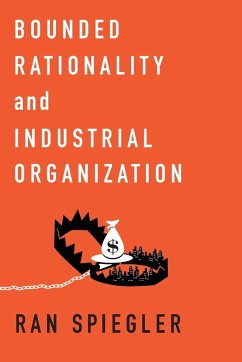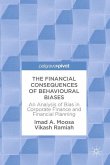- Broschiertes Buch
- Merkliste
- Auf die Merkliste
- Bewerten Bewerten
- Teilen
- Produkt teilen
- Produkterinnerung
- Produkterinnerung
Grounded in key observations in consumer psychology, Bounded Rationality and Industrial Organization develops non-standard models of "boundedly rational" consumer behavior and embeds them into familiar models of markets.
Andere Kunden interessierten sich auch für
![Social Norms, Bounded Rationality and Optimal Contracts Social Norms, Bounded Rationality and Optimal Contracts]() Suren BasovSocial Norms, Bounded Rationality and Optimal Contracts74,99 €
Suren BasovSocial Norms, Bounded Rationality and Optimal Contracts74,99 €![Social Norms, Bounded Rationality and Optimal Contracts Social Norms, Bounded Rationality and Optimal Contracts]() Suren BasovSocial Norms, Bounded Rationality and Optimal Contracts74,99 €
Suren BasovSocial Norms, Bounded Rationality and Optimal Contracts74,99 €![Behavioral Economics Behavioral Economics]() Fabrizio GhiselliniBehavioral Economics95,99 €
Fabrizio GhiselliniBehavioral Economics95,99 €![Behavioral Economics Behavioral Economics]() Fabrizio GhiselliniBehavioral Economics95,99 €
Fabrizio GhiselliniBehavioral Economics95,99 €![The End of Rationality and Selfishness The End of Rationality and Selfishness]() Rui-Wu WangThe End of Rationality and Selfishness88,99 €
Rui-Wu WangThe End of Rationality and Selfishness88,99 €![Ethics, Economics and Social Institutions Ethics, Economics and Social Institutions]() Vishwanath PanditEthics, Economics and Social Institutions74,99 €
Vishwanath PanditEthics, Economics and Social Institutions74,99 €![The Financial Consequences of Behavioural Biases The Financial Consequences of Behavioural Biases]() Imad A. MoosaThe Financial Consequences of Behavioural Biases41,99 €
Imad A. MoosaThe Financial Consequences of Behavioural Biases41,99 €-
-
-
Grounded in key observations in consumer psychology, Bounded Rationality and Industrial Organization develops non-standard models of "boundedly rational" consumer behavior and embeds them into familiar models of markets.
Hinweis: Dieser Artikel kann nur an eine deutsche Lieferadresse ausgeliefert werden.
Hinweis: Dieser Artikel kann nur an eine deutsche Lieferadresse ausgeliefert werden.
Produktdetails
- Produktdetails
- Verlag: Oxford University Press
- Seitenzahl: 240
- Erscheinungstermin: 1. Februar 2014
- Englisch
- Abmessung: 234mm x 156mm x 13mm
- Gewicht: 371g
- ISBN-13: 9780199334261
- ISBN-10: 0199334269
- Artikelnr.: 39171694
- Herstellerkennzeichnung
- Produktsicherheitsverantwortliche/r
- Europaallee 1
- 36244 Bad Hersfeld
- gpsr@libri.de
- Verlag: Oxford University Press
- Seitenzahl: 240
- Erscheinungstermin: 1. Februar 2014
- Englisch
- Abmessung: 234mm x 156mm x 13mm
- Gewicht: 371g
- ISBN-13: 9780199334261
- ISBN-10: 0199334269
- Artikelnr.: 39171694
- Herstellerkennzeichnung
- Produktsicherheitsverantwortliche/r
- Europaallee 1
- 36244 Bad Hersfeld
- gpsr@libri.de
Professor of Economics at Tel Aviv University and University College London
* 1 Introduction
* 1.1 Bibliographic Notes
* I Anticipating Future Preferences
* 2 Dynamically Inconsistent Preferences I: Unconstrained Contracting
* 2.1 The Multi-Selves Model
* 2.1.1 Naivety
* 2.2 Monopoly Pricing
* 2.2.1 Optimal Price Schemes for Sophisticated Consumers
* 2.2.2 Optimal Price Schemes for Naive Consumers
* 2.2.3 Screening the Consumer's Type
* 2.3 Competitive Pricing
* 2.4 Welfare Analysis
* 2.5 Educating Naive Consumers
* 2.6 The Interpretation of Naivety
* 2.7 Two Applications
* 2.8 Other Topics
* 2.8.1 The (?, ?) Model
* 2.8.2 Preference Heterogeneity
* 2.9 Summary
* 2.10 Bibliographic Notes
* 3 Dynamically Inconsistent Preferences II: Constrained Contracting
* 3.1 Two-Part Tariffs
* 3.1.1 Departure from Marginal-Cost Pricing
* 3.1.2 Welfare Analysis
* 3.2 Destabilization of Commitment Devices: Renegotiation and Spot
Market
* Competition
* 3.3 Self-Control
* 3.3.1 Implications for Monopoly Pricing
* 3.3.2 Do Self-Control Costs Hamper Competition?
* 3.4 Summary
* 3.5 Bibliographic Notes
* 4 Dynamically Inconsistent Preferences III: Partial Naivety
* 4.1 Magnitude Naivety
* 4.1.1 Monopoly Pricing
* 4.1.2 Are More Sophisticated Consumers Always Better Off?
* 4.2 Frequency Naivety
* 4.2.1 First-Best Monopoly Pricing
* 4.2.2 Second-Best Monopoly Pricing
* 4.2.3 Does Competition Curb Exploitation?
* 4.3 Summary
* 4.4 Bibliographic Notes
* 5 Biased Beliefs without Dynamic Inconsistency
* 5.1 Monopoly Pricing with Over-Optimistic Consumers
* 5.1.1 Comparison with Related Models
* 5.2 Overconfidence: Three-Part Tariffs
* 5.3 Unforeseen Contingencies: Add-On Pricing
* 5.4 A Summary Exercise: Insurance Markets with Biased Consumers
* 5.4.1 Equilibrium Analysis when Subjective Beliefs are Observable
* 5.4.2 Equilibrium Analysis when Subjective Beliefs are Private
Information
* 5.5 Summary
* 5.6 Bibliographic notes
* A Appendix to Part I: A Decision-Theoretic Perspective
* A.1 The Multi-Selves Model
* A.2 Self-Control Preferences
* A.3 The Relation between Self-Control Preferences and the
Multi-Selves Model
* A.4 Other Classes of Temptation-Driven Preferences
* A.5 Bibliographic Notes
* II Responding to Market Complexity
* 6 Sampling-Based Reasoning: Price Competition and Product
Differentiation
* 6.1 A Sampling-Based Choice Procedure
* 6.2 Price Competition and Technology Adoption
* 6.2.1 Nash Equilibrium
* 6.2.2 Welfare Analysis
* 6.3 Spurious Product Differentiation
* 6.3.1 Nash Equilibrium
* 6.3.2 Product Complexity as a Differentiation Device
* 6.4 Can the Market Educate Consumers?
* 6.5 Summary
* 6.6 Bibliographic Notes
* 7 Sampling-Based Reasoning: Obfuscation
* 7.1 A Model of Competitive Obfuscation
* 7.1.1 Nash Equilibrium
* 7.1.2 Welfare Analysis
* 7.2 Production Inefficiencies
* 7.3 Multi-Dimensional Prices
* 7.4 A Market Intervention: Introducing \Simple" Options
* 7.5 Summary
* 7.6 Bibliographic Notes
* 8 Coarse Reasoning
* 8.1 A Modeling Framework
* 8.2 Complex Price Patterns as a Discrimination Device
* 8.2.1 "DeBruijn" Price Sequences
* 8.2.2 Conditions for Profitability of Complex Price Patterns
* 8.3 Limited Understanding of Adverse Selection
* 8.3.1 A Buyer-Seller Example
* 8.3.2 A Benchmark: A Bayesian-Rational Buyer
* 8.3.3 A \Coarse" Buyer
* 8.3.4 Action-Dependent Feedback
* 8.4 Summary
* 8.5 Bibliographic Notes
* III Reference Dependence
* 9 Loss Aversion
* 9.1 Expected Price as a Reference Point: Monopoly Pricing
* 9.1.1 Reduced Price Variability
* 9.1.2 Impact on Expected Prices
* 9.2 Price Uniformity in a Duopoly Setting: \Kinked" Demand
* 9.3 Expected Consumption as a Reference Point: An \Attachment Effect"
* 9.3.1 Personal Equilibrium
* 9.3.2 Price Randomization
* 9.4 Discussion
* 9.4.1 Actual Prices as Reference Points
* 9.4.2 Pleasant Surprises
* 9.5 Summary
* 9.6 Bibliographic Notes
* 10 Inertia I: Price Competition
* 10.1 Price Competition under Consumer Inertia
* 10.2 Price-Frame Competition
* 10.2.1 Nash Equilibrium
* 10.2.2 Equilibrium Properties
* 10.2.3 Two Market Interventions
* 10.3 Consumer Switching
* 10.4 Asymmetric Default Assignment
* 10.5 A Few General Remarks
* 10.5.1 More than Two Frames
* 10.5.2 Revealed Preferences
* 10.6 Summary
* 10.7 Bibliographic Notes
* 11 Inertia II: Costly Marketing 261
* 11.1 A Model of Competitive Marketing
* 11.2 Nash Equilibrium
* 11.3 The Effective Marketing Property
* 11.4 Discussion
* 11.5 Summary
* 11.6 Bibliographic Notes
* IV Discussion
* 12 Recurring Themes
* 12.1 Complex Pricing Strategies
* 12.2 Spurious Variety
* 12.3 Market Transactions as a Form of Speculative Trade
* 12.4 How Effective are Competition and Consumer Protection Policies?
* 12.5 Externalities between Rational and Boundedly Rational Consumers
* 12.6 Conclusion
* 13 But Can't we Get the Same Thing with a Standard Model?
* 13.1 Rationalization via Modified Information
* 13.2 Rationalization via Modified Preferences
* 13.3 Rationalization via Endogenization
* 13.4 Discussion
* 13.5 Epilogue
* 13.6 Bibliographic Notes
* Bibliography
* Index
* 1.1 Bibliographic Notes
* I Anticipating Future Preferences
* 2 Dynamically Inconsistent Preferences I: Unconstrained Contracting
* 2.1 The Multi-Selves Model
* 2.1.1 Naivety
* 2.2 Monopoly Pricing
* 2.2.1 Optimal Price Schemes for Sophisticated Consumers
* 2.2.2 Optimal Price Schemes for Naive Consumers
* 2.2.3 Screening the Consumer's Type
* 2.3 Competitive Pricing
* 2.4 Welfare Analysis
* 2.5 Educating Naive Consumers
* 2.6 The Interpretation of Naivety
* 2.7 Two Applications
* 2.8 Other Topics
* 2.8.1 The (?, ?) Model
* 2.8.2 Preference Heterogeneity
* 2.9 Summary
* 2.10 Bibliographic Notes
* 3 Dynamically Inconsistent Preferences II: Constrained Contracting
* 3.1 Two-Part Tariffs
* 3.1.1 Departure from Marginal-Cost Pricing
* 3.1.2 Welfare Analysis
* 3.2 Destabilization of Commitment Devices: Renegotiation and Spot
Market
* Competition
* 3.3 Self-Control
* 3.3.1 Implications for Monopoly Pricing
* 3.3.2 Do Self-Control Costs Hamper Competition?
* 3.4 Summary
* 3.5 Bibliographic Notes
* 4 Dynamically Inconsistent Preferences III: Partial Naivety
* 4.1 Magnitude Naivety
* 4.1.1 Monopoly Pricing
* 4.1.2 Are More Sophisticated Consumers Always Better Off?
* 4.2 Frequency Naivety
* 4.2.1 First-Best Monopoly Pricing
* 4.2.2 Second-Best Monopoly Pricing
* 4.2.3 Does Competition Curb Exploitation?
* 4.3 Summary
* 4.4 Bibliographic Notes
* 5 Biased Beliefs without Dynamic Inconsistency
* 5.1 Monopoly Pricing with Over-Optimistic Consumers
* 5.1.1 Comparison with Related Models
* 5.2 Overconfidence: Three-Part Tariffs
* 5.3 Unforeseen Contingencies: Add-On Pricing
* 5.4 A Summary Exercise: Insurance Markets with Biased Consumers
* 5.4.1 Equilibrium Analysis when Subjective Beliefs are Observable
* 5.4.2 Equilibrium Analysis when Subjective Beliefs are Private
Information
* 5.5 Summary
* 5.6 Bibliographic notes
* A Appendix to Part I: A Decision-Theoretic Perspective
* A.1 The Multi-Selves Model
* A.2 Self-Control Preferences
* A.3 The Relation between Self-Control Preferences and the
Multi-Selves Model
* A.4 Other Classes of Temptation-Driven Preferences
* A.5 Bibliographic Notes
* II Responding to Market Complexity
* 6 Sampling-Based Reasoning: Price Competition and Product
Differentiation
* 6.1 A Sampling-Based Choice Procedure
* 6.2 Price Competition and Technology Adoption
* 6.2.1 Nash Equilibrium
* 6.2.2 Welfare Analysis
* 6.3 Spurious Product Differentiation
* 6.3.1 Nash Equilibrium
* 6.3.2 Product Complexity as a Differentiation Device
* 6.4 Can the Market Educate Consumers?
* 6.5 Summary
* 6.6 Bibliographic Notes
* 7 Sampling-Based Reasoning: Obfuscation
* 7.1 A Model of Competitive Obfuscation
* 7.1.1 Nash Equilibrium
* 7.1.2 Welfare Analysis
* 7.2 Production Inefficiencies
* 7.3 Multi-Dimensional Prices
* 7.4 A Market Intervention: Introducing \Simple" Options
* 7.5 Summary
* 7.6 Bibliographic Notes
* 8 Coarse Reasoning
* 8.1 A Modeling Framework
* 8.2 Complex Price Patterns as a Discrimination Device
* 8.2.1 "DeBruijn" Price Sequences
* 8.2.2 Conditions for Profitability of Complex Price Patterns
* 8.3 Limited Understanding of Adverse Selection
* 8.3.1 A Buyer-Seller Example
* 8.3.2 A Benchmark: A Bayesian-Rational Buyer
* 8.3.3 A \Coarse" Buyer
* 8.3.4 Action-Dependent Feedback
* 8.4 Summary
* 8.5 Bibliographic Notes
* III Reference Dependence
* 9 Loss Aversion
* 9.1 Expected Price as a Reference Point: Monopoly Pricing
* 9.1.1 Reduced Price Variability
* 9.1.2 Impact on Expected Prices
* 9.2 Price Uniformity in a Duopoly Setting: \Kinked" Demand
* 9.3 Expected Consumption as a Reference Point: An \Attachment Effect"
* 9.3.1 Personal Equilibrium
* 9.3.2 Price Randomization
* 9.4 Discussion
* 9.4.1 Actual Prices as Reference Points
* 9.4.2 Pleasant Surprises
* 9.5 Summary
* 9.6 Bibliographic Notes
* 10 Inertia I: Price Competition
* 10.1 Price Competition under Consumer Inertia
* 10.2 Price-Frame Competition
* 10.2.1 Nash Equilibrium
* 10.2.2 Equilibrium Properties
* 10.2.3 Two Market Interventions
* 10.3 Consumer Switching
* 10.4 Asymmetric Default Assignment
* 10.5 A Few General Remarks
* 10.5.1 More than Two Frames
* 10.5.2 Revealed Preferences
* 10.6 Summary
* 10.7 Bibliographic Notes
* 11 Inertia II: Costly Marketing 261
* 11.1 A Model of Competitive Marketing
* 11.2 Nash Equilibrium
* 11.3 The Effective Marketing Property
* 11.4 Discussion
* 11.5 Summary
* 11.6 Bibliographic Notes
* IV Discussion
* 12 Recurring Themes
* 12.1 Complex Pricing Strategies
* 12.2 Spurious Variety
* 12.3 Market Transactions as a Form of Speculative Trade
* 12.4 How Effective are Competition and Consumer Protection Policies?
* 12.5 Externalities between Rational and Boundedly Rational Consumers
* 12.6 Conclusion
* 13 But Can't we Get the Same Thing with a Standard Model?
* 13.1 Rationalization via Modified Information
* 13.2 Rationalization via Modified Preferences
* 13.3 Rationalization via Endogenization
* 13.4 Discussion
* 13.5 Epilogue
* 13.6 Bibliographic Notes
* Bibliography
* Index
* 1 Introduction
* 1.1 Bibliographic Notes
* I Anticipating Future Preferences
* 2 Dynamically Inconsistent Preferences I: Unconstrained Contracting
* 2.1 The Multi-Selves Model
* 2.1.1 Naivety
* 2.2 Monopoly Pricing
* 2.2.1 Optimal Price Schemes for Sophisticated Consumers
* 2.2.2 Optimal Price Schemes for Naive Consumers
* 2.2.3 Screening the Consumer's Type
* 2.3 Competitive Pricing
* 2.4 Welfare Analysis
* 2.5 Educating Naive Consumers
* 2.6 The Interpretation of Naivety
* 2.7 Two Applications
* 2.8 Other Topics
* 2.8.1 The (?, ?) Model
* 2.8.2 Preference Heterogeneity
* 2.9 Summary
* 2.10 Bibliographic Notes
* 3 Dynamically Inconsistent Preferences II: Constrained Contracting
* 3.1 Two-Part Tariffs
* 3.1.1 Departure from Marginal-Cost Pricing
* 3.1.2 Welfare Analysis
* 3.2 Destabilization of Commitment Devices: Renegotiation and Spot
Market
* Competition
* 3.3 Self-Control
* 3.3.1 Implications for Monopoly Pricing
* 3.3.2 Do Self-Control Costs Hamper Competition?
* 3.4 Summary
* 3.5 Bibliographic Notes
* 4 Dynamically Inconsistent Preferences III: Partial Naivety
* 4.1 Magnitude Naivety
* 4.1.1 Monopoly Pricing
* 4.1.2 Are More Sophisticated Consumers Always Better Off?
* 4.2 Frequency Naivety
* 4.2.1 First-Best Monopoly Pricing
* 4.2.2 Second-Best Monopoly Pricing
* 4.2.3 Does Competition Curb Exploitation?
* 4.3 Summary
* 4.4 Bibliographic Notes
* 5 Biased Beliefs without Dynamic Inconsistency
* 5.1 Monopoly Pricing with Over-Optimistic Consumers
* 5.1.1 Comparison with Related Models
* 5.2 Overconfidence: Three-Part Tariffs
* 5.3 Unforeseen Contingencies: Add-On Pricing
* 5.4 A Summary Exercise: Insurance Markets with Biased Consumers
* 5.4.1 Equilibrium Analysis when Subjective Beliefs are Observable
* 5.4.2 Equilibrium Analysis when Subjective Beliefs are Private
Information
* 5.5 Summary
* 5.6 Bibliographic notes
* A Appendix to Part I: A Decision-Theoretic Perspective
* A.1 The Multi-Selves Model
* A.2 Self-Control Preferences
* A.3 The Relation between Self-Control Preferences and the
Multi-Selves Model
* A.4 Other Classes of Temptation-Driven Preferences
* A.5 Bibliographic Notes
* II Responding to Market Complexity
* 6 Sampling-Based Reasoning: Price Competition and Product
Differentiation
* 6.1 A Sampling-Based Choice Procedure
* 6.2 Price Competition and Technology Adoption
* 6.2.1 Nash Equilibrium
* 6.2.2 Welfare Analysis
* 6.3 Spurious Product Differentiation
* 6.3.1 Nash Equilibrium
* 6.3.2 Product Complexity as a Differentiation Device
* 6.4 Can the Market Educate Consumers?
* 6.5 Summary
* 6.6 Bibliographic Notes
* 7 Sampling-Based Reasoning: Obfuscation
* 7.1 A Model of Competitive Obfuscation
* 7.1.1 Nash Equilibrium
* 7.1.2 Welfare Analysis
* 7.2 Production Inefficiencies
* 7.3 Multi-Dimensional Prices
* 7.4 A Market Intervention: Introducing \Simple" Options
* 7.5 Summary
* 7.6 Bibliographic Notes
* 8 Coarse Reasoning
* 8.1 A Modeling Framework
* 8.2 Complex Price Patterns as a Discrimination Device
* 8.2.1 "DeBruijn" Price Sequences
* 8.2.2 Conditions for Profitability of Complex Price Patterns
* 8.3 Limited Understanding of Adverse Selection
* 8.3.1 A Buyer-Seller Example
* 8.3.2 A Benchmark: A Bayesian-Rational Buyer
* 8.3.3 A \Coarse" Buyer
* 8.3.4 Action-Dependent Feedback
* 8.4 Summary
* 8.5 Bibliographic Notes
* III Reference Dependence
* 9 Loss Aversion
* 9.1 Expected Price as a Reference Point: Monopoly Pricing
* 9.1.1 Reduced Price Variability
* 9.1.2 Impact on Expected Prices
* 9.2 Price Uniformity in a Duopoly Setting: \Kinked" Demand
* 9.3 Expected Consumption as a Reference Point: An \Attachment Effect"
* 9.3.1 Personal Equilibrium
* 9.3.2 Price Randomization
* 9.4 Discussion
* 9.4.1 Actual Prices as Reference Points
* 9.4.2 Pleasant Surprises
* 9.5 Summary
* 9.6 Bibliographic Notes
* 10 Inertia I: Price Competition
* 10.1 Price Competition under Consumer Inertia
* 10.2 Price-Frame Competition
* 10.2.1 Nash Equilibrium
* 10.2.2 Equilibrium Properties
* 10.2.3 Two Market Interventions
* 10.3 Consumer Switching
* 10.4 Asymmetric Default Assignment
* 10.5 A Few General Remarks
* 10.5.1 More than Two Frames
* 10.5.2 Revealed Preferences
* 10.6 Summary
* 10.7 Bibliographic Notes
* 11 Inertia II: Costly Marketing 261
* 11.1 A Model of Competitive Marketing
* 11.2 Nash Equilibrium
* 11.3 The Effective Marketing Property
* 11.4 Discussion
* 11.5 Summary
* 11.6 Bibliographic Notes
* IV Discussion
* 12 Recurring Themes
* 12.1 Complex Pricing Strategies
* 12.2 Spurious Variety
* 12.3 Market Transactions as a Form of Speculative Trade
* 12.4 How Effective are Competition and Consumer Protection Policies?
* 12.5 Externalities between Rational and Boundedly Rational Consumers
* 12.6 Conclusion
* 13 But Can't we Get the Same Thing with a Standard Model?
* 13.1 Rationalization via Modified Information
* 13.2 Rationalization via Modified Preferences
* 13.3 Rationalization via Endogenization
* 13.4 Discussion
* 13.5 Epilogue
* 13.6 Bibliographic Notes
* Bibliography
* Index
* 1.1 Bibliographic Notes
* I Anticipating Future Preferences
* 2 Dynamically Inconsistent Preferences I: Unconstrained Contracting
* 2.1 The Multi-Selves Model
* 2.1.1 Naivety
* 2.2 Monopoly Pricing
* 2.2.1 Optimal Price Schemes for Sophisticated Consumers
* 2.2.2 Optimal Price Schemes for Naive Consumers
* 2.2.3 Screening the Consumer's Type
* 2.3 Competitive Pricing
* 2.4 Welfare Analysis
* 2.5 Educating Naive Consumers
* 2.6 The Interpretation of Naivety
* 2.7 Two Applications
* 2.8 Other Topics
* 2.8.1 The (?, ?) Model
* 2.8.2 Preference Heterogeneity
* 2.9 Summary
* 2.10 Bibliographic Notes
* 3 Dynamically Inconsistent Preferences II: Constrained Contracting
* 3.1 Two-Part Tariffs
* 3.1.1 Departure from Marginal-Cost Pricing
* 3.1.2 Welfare Analysis
* 3.2 Destabilization of Commitment Devices: Renegotiation and Spot
Market
* Competition
* 3.3 Self-Control
* 3.3.1 Implications for Monopoly Pricing
* 3.3.2 Do Self-Control Costs Hamper Competition?
* 3.4 Summary
* 3.5 Bibliographic Notes
* 4 Dynamically Inconsistent Preferences III: Partial Naivety
* 4.1 Magnitude Naivety
* 4.1.1 Monopoly Pricing
* 4.1.2 Are More Sophisticated Consumers Always Better Off?
* 4.2 Frequency Naivety
* 4.2.1 First-Best Monopoly Pricing
* 4.2.2 Second-Best Monopoly Pricing
* 4.2.3 Does Competition Curb Exploitation?
* 4.3 Summary
* 4.4 Bibliographic Notes
* 5 Biased Beliefs without Dynamic Inconsistency
* 5.1 Monopoly Pricing with Over-Optimistic Consumers
* 5.1.1 Comparison with Related Models
* 5.2 Overconfidence: Three-Part Tariffs
* 5.3 Unforeseen Contingencies: Add-On Pricing
* 5.4 A Summary Exercise: Insurance Markets with Biased Consumers
* 5.4.1 Equilibrium Analysis when Subjective Beliefs are Observable
* 5.4.2 Equilibrium Analysis when Subjective Beliefs are Private
Information
* 5.5 Summary
* 5.6 Bibliographic notes
* A Appendix to Part I: A Decision-Theoretic Perspective
* A.1 The Multi-Selves Model
* A.2 Self-Control Preferences
* A.3 The Relation between Self-Control Preferences and the
Multi-Selves Model
* A.4 Other Classes of Temptation-Driven Preferences
* A.5 Bibliographic Notes
* II Responding to Market Complexity
* 6 Sampling-Based Reasoning: Price Competition and Product
Differentiation
* 6.1 A Sampling-Based Choice Procedure
* 6.2 Price Competition and Technology Adoption
* 6.2.1 Nash Equilibrium
* 6.2.2 Welfare Analysis
* 6.3 Spurious Product Differentiation
* 6.3.1 Nash Equilibrium
* 6.3.2 Product Complexity as a Differentiation Device
* 6.4 Can the Market Educate Consumers?
* 6.5 Summary
* 6.6 Bibliographic Notes
* 7 Sampling-Based Reasoning: Obfuscation
* 7.1 A Model of Competitive Obfuscation
* 7.1.1 Nash Equilibrium
* 7.1.2 Welfare Analysis
* 7.2 Production Inefficiencies
* 7.3 Multi-Dimensional Prices
* 7.4 A Market Intervention: Introducing \Simple" Options
* 7.5 Summary
* 7.6 Bibliographic Notes
* 8 Coarse Reasoning
* 8.1 A Modeling Framework
* 8.2 Complex Price Patterns as a Discrimination Device
* 8.2.1 "DeBruijn" Price Sequences
* 8.2.2 Conditions for Profitability of Complex Price Patterns
* 8.3 Limited Understanding of Adverse Selection
* 8.3.1 A Buyer-Seller Example
* 8.3.2 A Benchmark: A Bayesian-Rational Buyer
* 8.3.3 A \Coarse" Buyer
* 8.3.4 Action-Dependent Feedback
* 8.4 Summary
* 8.5 Bibliographic Notes
* III Reference Dependence
* 9 Loss Aversion
* 9.1 Expected Price as a Reference Point: Monopoly Pricing
* 9.1.1 Reduced Price Variability
* 9.1.2 Impact on Expected Prices
* 9.2 Price Uniformity in a Duopoly Setting: \Kinked" Demand
* 9.3 Expected Consumption as a Reference Point: An \Attachment Effect"
* 9.3.1 Personal Equilibrium
* 9.3.2 Price Randomization
* 9.4 Discussion
* 9.4.1 Actual Prices as Reference Points
* 9.4.2 Pleasant Surprises
* 9.5 Summary
* 9.6 Bibliographic Notes
* 10 Inertia I: Price Competition
* 10.1 Price Competition under Consumer Inertia
* 10.2 Price-Frame Competition
* 10.2.1 Nash Equilibrium
* 10.2.2 Equilibrium Properties
* 10.2.3 Two Market Interventions
* 10.3 Consumer Switching
* 10.4 Asymmetric Default Assignment
* 10.5 A Few General Remarks
* 10.5.1 More than Two Frames
* 10.5.2 Revealed Preferences
* 10.6 Summary
* 10.7 Bibliographic Notes
* 11 Inertia II: Costly Marketing 261
* 11.1 A Model of Competitive Marketing
* 11.2 Nash Equilibrium
* 11.3 The Effective Marketing Property
* 11.4 Discussion
* 11.5 Summary
* 11.6 Bibliographic Notes
* IV Discussion
* 12 Recurring Themes
* 12.1 Complex Pricing Strategies
* 12.2 Spurious Variety
* 12.3 Market Transactions as a Form of Speculative Trade
* 12.4 How Effective are Competition and Consumer Protection Policies?
* 12.5 Externalities between Rational and Boundedly Rational Consumers
* 12.6 Conclusion
* 13 But Can't we Get the Same Thing with a Standard Model?
* 13.1 Rationalization via Modified Information
* 13.2 Rationalization via Modified Preferences
* 13.3 Rationalization via Endogenization
* 13.4 Discussion
* 13.5 Epilogue
* 13.6 Bibliographic Notes
* Bibliography
* Index








